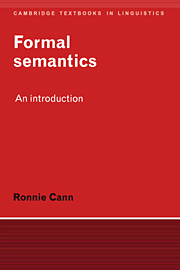Book contents
- Frontmatter
- Contents
- List of figures
- Preface
- List of symbols
- 1 INTRODUCTION
- 2 PREDICATES AND ARGUMENTS
- 3 NEGATION AND CO-ORDINATION
- 4 TYPE THEORY
- 5 THE LAMBDA OPERATOR
- 6 QUANTIFICATION
- 7 INFERENCE
- 8 TIME, TENSE AND ASPECT
- 9 POSSIBLE WORLDS
- 10 INTENSIONAL SEMANTICS
- Answers to selected exercises
- References
- Index
8 - TIME, TENSE AND ASPECT
Published online by Cambridge University Press: 05 June 2012
- Frontmatter
- Contents
- List of figures
- Preface
- List of symbols
- 1 INTRODUCTION
- 2 PREDICATES AND ARGUMENTS
- 3 NEGATION AND CO-ORDINATION
- 4 TYPE THEORY
- 5 THE LAMBDA OPERATOR
- 6 QUANTIFICATION
- 7 INFERENCE
- 8 TIME, TENSE AND ASPECT
- 9 POSSIBLE WORLDS
- 10 INTENSIONAL SEMANTICS
- Answers to selected exercises
- References
- Index
Summary
Temporal contingency
The grammar fragment developed in previous chapters generates sentences only in the past tense form. This has been a matter of expediency to allow more natural English to be used for the examples. However, the temporal properties of the sentences implied by the use of this tense have, in fact, been completely absent from their interpretation. The models we have been working with only contain a set of basic entities, A, and a function F which assigns an extension to each lexeme in the language. The denotations assigned by the latter are, however, static and no notion of change or development is (or could be) incorporated. This means that really the model theory treats all formulas as universal truths or universal falsehoods, as if they were all of the same sort as sentences like e = mc2, All humans are mortal, No bachelors are unmarried, The square root of nine is seventeen, and so on. The propositions expressed by such sentences have the same truth value at all times and so may be thought of as ‘timeless’. Most of the sentences generated by the grammar fragment, however, translate into formulae that could vary in truth value according to time and place, and other contextual factors. For example, A lecturer screamed may be true if uttered today but false if uttered the day before yesterday. Such sentences do not denote universal truths or falsehoods but contingent ones, ones whose truth depends on what is happening or has happened at a particular time.
- Type
- Chapter
- Information
- Formal SemanticsAn Introduction, pp. 233 - 262Publisher: Cambridge University PressPrint publication year: 1993



